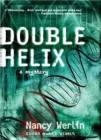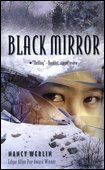 The first one I knocked off was Double Helix, which was, you might say, serendipitous because it played right into my father fixation. Nancy says of the book at her website, "In particular, it's a father-son story. And that, rather than in news stories about genetics, is where the novel had its start...Originally, I imagined a triangle in which two men, Jonathan Samuels and Dr. Quincy Wyatt, struggle for the soul of the novel’s hero, eighteen-year old Eli Samuels. Which man’s influence will form Eli? I wondered. To whom will he pledge his future and his loyalty?"
The first one I knocked off was Double Helix, which was, you might say, serendipitous because it played right into my father fixation. Nancy says of the book at her website, "In particular, it's a father-son story. And that, rather than in news stories about genetics, is where the novel had its start...Originally, I imagined a triangle in which two men, Jonathan Samuels and Dr. Quincy Wyatt, struggle for the soul of the novel’s hero, eighteen-year old Eli Samuels. Which man’s influence will form Eli? I wondered. To whom will he pledge his future and his loyalty?"Yes! Yes! I originally saw the triangle as two father figures fighting for a young guy. At one point, I was finishing up doing something so I could go back to reading to see which Dad won. But that's oversimplifying because as Nancy also says, one dad had it all over the other one.
At various points while reading this book, I thought I knew what was going to happen next. And I did. But not entirely. Every time there was something just a little different and unexpected.
 Next I whipped through Black Mirror. While reading this one, I wondered if the main character wasn't a little too troubled. Her personal problems seemed to keep her from understanding what was going on for way too long. But that may have been the point. She's not Nancy Drew. What was going on around her was apart from her. In fact, she doesn't have anything to do with ending the criminal activity. In terms of her personal story, the real climax comes from the revelation that occurs after the thriller storyline is done. And the really important revelation isn't whodunnit (though we learn that) but who the victim really was.
Next I whipped through Black Mirror. While reading this one, I wondered if the main character wasn't a little too troubled. Her personal problems seemed to keep her from understanding what was going on for way too long. But that may have been the point. She's not Nancy Drew. What was going on around her was apart from her. In fact, she doesn't have anything to do with ending the criminal activity. In terms of her personal story, the real climax comes from the revelation that occurs after the thriller storyline is done. And the really important revelation isn't whodunnit (though we learn that) but who the victim really was.Black Mirror included an interesting secondary character whose identity I figured out early on. I liked him and his relationship with the main character, but while I was focusing on him, I totally missed what was really going on with two other characters. What was going on with them was realistic and worked, it was just a pleasant surprise to me.
 While I'm not fond of what I'll call locked-inside scenarios, Locked Inside includes my favorite main character of the three books. The book included the same abrupt (in the good sense of the word) surprises I'd come to expect after reading the two earlier ones. I started reading and thought, Oh. This is going to be a gaming story. But, then, wham! It wasn't. This is also the book that made me say, "Holy #@!!" right out loud.
While I'm not fond of what I'll call locked-inside scenarios, Locked Inside includes my favorite main character of the three books. The book included the same abrupt (in the good sense of the word) surprises I'd come to expect after reading the two earlier ones. I started reading and thought, Oh. This is going to be a gaming story. But, then, wham! It wasn't. This is also the book that made me say, "Holy #@!!" right out loud.As I was reading these books, I kept thinking of Ruth Rendell's stand alone novels. (She also does a series of police procedurals.) The New York Times said of Rendell's books, "Ms. Rendell's central characters are frequently in a state of intense anxiety." In the three Werlin books I read, the central characters are anxious. They are, in fact, close to being traumatized by loss, whether recent, expected, or in the past. The NYTimes also said that "Rendell's books depend on precision of detail." Each of these Werlin books involved a completely different character background--science, Buddhism, gaming--requiring entirely new material to provide details.
Rendell fans talk about looking for the "new Rendell" or "picking up a Rendell." I imagine YA readers some day talking about Nancy Werlin's work in the same way.
Today's Training Report: Two entries for the 365 Story Project. Began charting story arcs for same. Two manuscript submissions, along with a little submission research. A little work on cleaning my desk.
4 comments:
I hope you'll read The Killer's Cousin too. It's a terrific read. As I remember it (this was eight years or more ago), I found the two main characters in Are You Alone on Purpose quite compelling. In part that's because the boy is not particularly sympathetic, and that's an unusual tack for an author to take, particularly in a J or YA novel. But I can't get my kids to read it. Impossible seems to be doing well, though it's a little early to tell. In general, I'm surprised that Werlin isn't more popular with my readers, because she writes so well and I think her storylines are intriguing.
I do plan to keep reading her, just as I keep reading Rendell. But after doing three Werlins in a row, I thought I would shift to something else for a while.
I didn't say much about the quality of the writing, but, yes, I was impressed, too. At points where my mind might have started to wander, the writing kept me. That and I came to realize that in all likelihood the story was going to shift in some unexpected way soon.
I'm late to the party here, Gail, but thanks for reading -- and especially for the Ruth Rendell mention.
I've moved away from mystery-type scenarios these days, but never will from thrillers. I like to think of myself as strapping readers in on a roller-coaster and I do search for ways in which to, er, give 'em whiplash.
Of course you noticed the FBI agent in Black Mirror. Was it the QUANTICO sweatshirt I put him in that gave you the clue?! Of course I could have made the sweatshirt red, as well.
(P.S. I utterly adore Marnie in Locked Inside too.)
This is embarrassing--I don't remember the QUANTICO sweatshirt. I must have missed it!
I think the guy was just--to my mind--so much cooler than the other kids. And I liked the main character's attraction to this dangerous guy who she couldn't have, not because he was dangerous but, actually, because he wasn't. But she didn't know that. I did.
Post a Comment